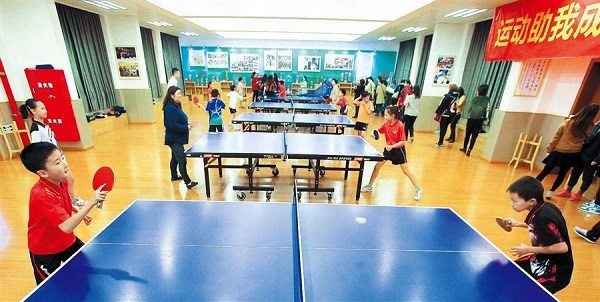- Home > News > Domestic News
- domestic news
Learning ABCs of fitness at a young age

Students at the Julu Road No. 1 Primary School play table tennis during class breaks. While the school is famous for cultivating table tennis stars, the game is also a tool for the school to promote student health.(Ye Chenliang)
The downtown Julu Road No.1 Primary School in Shanghai is filled with the frequent sound of students playing ping pong.
It's not only because the school is famous for cultivating table tennis stars and counts more than 10 national and world championships won by its alumni; the game is also a tool for the school to promote student health.
"We all like ping pong," one student told Shanghai Daily. "Our campus is small, and the game fits the space nicely. I like the exercise, too."
Besides a special training room for student athletes, the school has ping pong tables in every available corner and encourages all students to take up paddles during classroom breaks. It has also developed exercises to help students to attain optimum movements while practicing table tennis techniques.
School Principal Lou Haifeng said the emphasis on table tennis, along with education on balanced diets and general health, pays off in ways such as improved eyesight.
A 2013 examination found that nearly 40 percent of students at the school had poor vision. That rate dropped to 32 percent last year and to 25 percent among students who played table tennis regularly. The rate of obesity also decreased sharply.
Luo Chunyan, director of the children's health division of the Shanghai Disease Control and Prevention Center, said poor vision and obesity are two common problems in the health of school children.
The Julu Road school also uses picture books and games to increase the mental acuity of students.
Similar measures are in place in more than 1,000 local schools, since Shanghai began actively promoting the World Health Organization concept of health in education in 1995. That year, the city initiated a special program under the guidance of the WHO Western Pacific Regional Office.
Between 1996 and 2004, the city introduced health promotion in schools, centering on four initial targets: discouraging smoking, improving nutrition, preventing accidental injuries and thwarting unprotected sex.
In 2000, education and health authorities in Shanghai released plans to promote health education in schools, and 48 local schools were tapped to participate in 2003.
Since that year, the Shanghai government has issued a series of three-year action plans aimed at turning Shanghai into what it calls Healthy City. The Shanghai Education Commission launched a tandem campaign to expand health education in schools across the city.
According to a survey, more than 95 percent of local schools now ensure that students have at least 20 minutes of health education each week and one hour of sports activity each day.
More than 65 percent of students now show knowledge of basic health principles and nearly 89 percent of the students are satisfied with the sports and exercise facilities in their schools, the survey found.
Another survey conducted between 2012 and 2014 showed that 94 percent of students interviewed reported that their schools offered psychological counseling.
To facilitate better diets, the city has been improving the sanitary conditions and menus in school canteens. Some 95 percent of the students eat at school, and the city has invested more than 200 million yuan (US$29 million) to ensure they get proper nutrition in meals made with quality ingredients.
Nutritionists have been hired to devise menus that meet nutrition standards and take into account the needs of growing students.
Shanghai Hong Xiong Primary School not only provides special exercise plans for overweight students, but also provides parents with low-calorie menu suggestions for children during vacations from school.
The city had also invested 100 million yuan to upgrade lighting in 1,415 local schools to protect students' eyesight.
Since 2007, education authorities have directed all schools to increase sports and exercise activities. Sports performance now counts for 30 points on the 630-point middle school graduation exam.
Students seem to like the emphasis on sports, which are popular courses. Each student is required to master one or two sport skills by graduation from high school.
A healthy lifestyle also includes sexual wellbeing.
The Primary School Affiliated to the University of Shanghai for Science and Technology is well-know for its sex education courses for both genders and also provides classes on self-protection against sexual assault.
- Previous:What they say
- Next:Public smoking ban to go nationwide
| Chinese Association on Tobacco Control Copyright © 1992-2011 906-907 Anhuidongli, Chaoyang District Beijing 100101 |